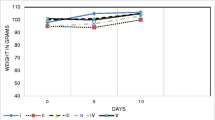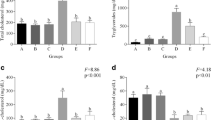Abstract
In this study, 12 months old female Swiss albino rats were used. They were randomly divided into four groups. The animals of group I were fed with pellet chow. Group II were fed with pellet chow and treated with 250 μg/kg CrCl3.6H2o and 100 mg/kg niacinfor 45 days. Group III were fed a lipogenic diet consisting of 2% cholesterol, 0.5% cholicacidand 2%sun flower oil added to the pellet chow, andgiven 3%alcoholic water for 60 days. Group IV were fed with the same lipogeni cdiet for 60 day sand treated by gavage technique to rats at a dose of 250 mu/kg CrCl3.6H2O and 100 mg/kg niacin for 45 days, 15 days after experimental animals were rendered hyperlipidemic. At the 60th day, renal tissue and blood samples were taken from the animals. The sections were examined under light and electron microscopy. The degenerative changes were much more in the hyperlipidemic rats than the control group. The changes in renal tissue were also observed in hyperlipidemic animals given niacin and chromium. In the hyperlipidemic rats, renal glutathione levels decreased and renal lipid peroxidation levels, and serum urea and creatinine levels were increased. But, renal glutathione levels increased and lipid peroxidation levels and serum urea and creatinine levels decreased in hyperlipidemic rats given niacin and chromium. The purpose of this study was to investigate whether a protective effect of a combination of niacin and chromium is present on the renal tissue of hyperlipidemic rats or not. In conclusion, we can say that niacin and chromium do not have a protective effect on the morphology of the renal tissue of hyperlipidemic rats, except a protective effect on their biochemical parameters.
Similar content being viewed by others
References
Campbell JD: Lifestyle, minerals and health. Med Hypotheses 57: 521–531, 2001
Snively CS, Gutierrez C: Chronic kidney disease: prevention and treatment of common complications. Am Fam Physician 70: 1921–1928, 2004
Kamanna VS, Roh DD, Kirschenbaum MA: Hyperlipidemia and kidney disease:concepts derived from histopathology and cell biology of the glomerulus. Histol Histopathol 13: 169–179, 1998
Zambon A, Hokanson JE, Brown BG, Brunzell JD: Evidence for a new pathophysiological mechanism for coronary artery disease regression. Am Heart Assoc 99: 1959–1964, 1999
Imai Y, Suzuki H, Saito T, Tsuji I, Abe K, Saruta T: The effect of pravastatin on renal function and lipid metabolism in patients with renal dysfunction with hypertension and hyperlipidemia. Clin Exp Hypertens 21: 1345–1355, 1999
Kumai T, Oonuma S, Kitaoka Y, Tadokoro M, Kobayashi S: Biochemical and morphological characterization of spontaneously hypertensive hyperlipidaemic rats. Clin Exp Pharmacol Physiol 30: 537–544, 2003
Madore F: Cardiac risk factors in renal disease. Med Sci 20: 1100–1103, 2004
Simonoff M: Chromium deficiency and cardiovascular risk. Cardiovas Res 18: 591–596, 1984
Bourn DM, Gibson RS Martinez OB, Macdonald AC: The effect of chromium supplementation on serum lipid levels in a selected sample of canadian postmenopausal women. Biol Trace Elem Res 9: 197–205, 1986
Anderson RA: Chromium metabolism its role in disease processes in man. Clin Physiol Biochem 4: 31–41, 1986
Vincent JB: Elucidating a biological role for chromium at a molecular level. Acc Chem Res 33: 503–510, 2000
Cohen MD, Kargacin B, Klein CB, Costa M: Mechanisms of chromium carcinogenicity and toxicity. Crit Rev Toxicol 23: 255–281, 1993
Morris B, Peacey SR, Macneil S, Gray T: Enhacement in insulin sensitivity in healthy volunteers following supplementation with chromium picolinate. Med Biochem 1: 65–72, 1998
Davies S, McLaren Howard J, Hunnisett A, Howard M: Age-related decreases in chromium levels in 51,665 hair, sweat and serum samples from 40,872 patients-implications for the prevention of cardiovascular disease and type II diabetes mellitus. Metabolism 46: 469–473, 1997
Rajpathak S, Rimm EB, Li T, Morris JS, Stampfer MJ, Willett WC, Hu FB: Lower toenail chromium in men with diabetes and cardiovascular disease compared with healthy men. Diabetes Care 27: 2211–2216, 2004
Anderson RA: Nutritional role of chromium. Sci Total Environ 17: 13–29, 1981
Racek J: Chromium as an essential element. Cas Lek Cesk 142: 335–339, 2003
Offenbacher EG, Pi-Sunyer FX: Beneficial effect of chromium-rich yeast on glucose tolerance and blood lipids in elderly subjects. Diabetes 29: 919–925, 1980
Wang MM, Fox EA, Stoecker BJ, Menendez CE, Chan SB: Serum cholesterol of adults supplemented with brewer&s yeast or chromium chloride. Nutr Res 9: 989–998, 1989
Superko HR, Krauss RM: Differential effects of nicotinic acid in subjects with different LDL subclass patterns. Atherosclerosis 95: 69–76, 1992
Goldberg AC: Clinical trial experience with extended-release niacin (Niaspan): Dose- escalation study. Am J Cardiol 82: 35U–38U, 1998
22 Capuzzi DM, Morgan JM, Brusco OA, Intenzo CM: Niacin dosing: relationship to benefits and adverse effects. Curr Atheroscler Rep 2: 64–71, 2000
23 Tavintharan S, Kashyap Benefits ML: The benefits of niacin in atherosclerosis. Curr Atheroscler Rep 3: 74–82, 2001
24 Morgan JM, Capuzzi DM, Guyton JR: A new extended-release niacin (niaspan): efficiacy, tolerabity, and safety in hypercholesterolemic patients. Am J Cardiol 82: 29U–34U, 1998
25 Goldberg A, Alagona P, Capuzzi DM, Guyton J, Morgan JM, Rodgers J, Sachson R, Samuel P: Multiple-dose efficiacy and safety of an extended-release form of niacin in the management of hyperlipidemia. Am J Cardiol 85: 1100–1105, 2000
Anderson RA, Polansky MM, Bryden NA, Patterson KY, Veillon C, Glinsmann WH: Effects of chromium supplementation on urinary Cr excretion of human subjects and correlation of Cr excretion with selected clinical parameters. J Nutr 113: 276–281, 1983
Roeback JR, Hla KM, Chambles LE, Fletcher RH: Effects of chromium supplementation on serum high-density lipoprotein cholesterol levels in men taking beta-blockers. Ann Intern Med 115: 917–924, 1991
Anderson RA, Bryden NA, Polansky MM, Gautschi, K: Dietary chromium effects on tissue chromium concentrations and chromium absorbtion in rats. J Trace Elem Exp Med 9: 11–25, 1996
Anderson RA, Bryden NA, Evock-Clover CM, Steele NC: Benificial effects of chromium on glucose and lipid variables in control and somatotropin-treated pigs are associated with increased tissue chromium and altered tissue cooper, iron, and zinc. J Anim Sci 75: 657–661, 1997
Kegley EB, Spears JW, Eisemann JH: Performance and glucose metabolism in calves fed a chromium-nicotinic acid complex or chromium chloride. J Dairy Sci 80: 1744–1750, 1997
Rikans LL, Arata D, Cederquist DC: Fatty livers produced in albino rats by excess niacin in high fat diets. II Effect of choline supplements. J Nutr 85: 107–112, 1965
Cohen L, Morgan J: Effectiveness of individualized long term therapy with niacin and probucol in reduction of serum cholesterol. J Fam Practice 26: 145–150, 1988
Brown BG, Bardsley J, Poulin D, Hillger LA, Dowdy A, Maher VMG, Zhao X-Q, Albers JJ, Knoop RH: Moderato dose, three-drug therapy with niacin, lovastatin, and colestipol to reduce low–density lipoprotein cholesterol<100 mg/dL in patients with hyperlipidemia and coronary artery disease. Am J Cardiol 80: 111–115, 1997
Guyton JR, Cappuzi DM: Treatment of hyperlipidemia with combined niacin-statin regimens. Am J Cardiol 82: 82U–84U, 1998
Preuss HG, Wallerstedt D, Talpur N, Tutuncuoglu SO, Echard B, Bui M, Bagchi D: Effect of niacin-bound chromium and grapeseed proanthocyanidin extract on the lipid profile of hypercholesterolemic subjects: A pilot study. J Med 31: 227–246, 2000
Ledwozyw A, Michalak J, Stepien A, Kadziolka A: The relationship plasma triglycerides, cholesterol, total lipids and lipid peroxidation products during human atherosclerosis. Clin Chim Acta 155: 275–284, 1986
Beutler E: Glutathione in red cell metabolism a manual of biochemical methods, 2nd edn. Grune and Stratton, New York, 1975, pp 112–114
Lowry OH, Rosebrough NJ, Farr AL, Randall RJ: Protein measurement with the folin phenol reagent. J Biol Chem 193: 265–275, 1951
Barker SB: The direct colorimetric determination of urea in blood and urine. J Biol Chem 152: 453–463, 1944
Bonsnes RW, Taussky, HH: On the colorimetric determination of creatinine by the Jaffe Reaction. J Biol Chem 158: 581–591, 1945
Hintze JL: Copyright C. 865, East 400. North Kaysville, Utah, 84,037(801), 546–0445, 1986
Tunez L, Munoz MC, Feijoo-Lopez AL, Valdvira E, Bujalance-Arenas L, Montilla P: Effect of melatonin on hyperlipidemic nephropathy under constant light exposure. J Physiol Biochem 58: 109–114, 2002
Rukkumani R, Sri, Balasubashini M, Vishwanathan P, Menon VP: Comparative effects of curcumin and photo-irradiated curcumin on alcohol-and polyunsaturated fatty acid-induced hyperlipidemia. Pharmacol Res 46: 257–264, 2002
Bolkent S, Yanardag R, Bolkent S, Doger MM: Beneficial effects of combined treatment with niacin and chromium on the liver of hyperlipemic rats. Biol Trace Elem Res 101: 219–230, 2004
Yanardag R, Peksel A, Yeŝilyaprak B. Doger MM, Arisan-Atac I: Effects of a combination of niacin and chromium (III)-chloride on the skin and lungs of hyperlipemic rats. Biol Trace Elem Res 103: 249–260, 2005
Scheuer H, Gwinner W, Hohbach J, Gröne EF, Brandes RP, Malle E, Olbricht CJ, Walli AK, Gröne HJ: Oxidant sterss in hyperlipidemia- induced renal damage. Am J Physiol Renal Physiol 278: F63–F74, 2000
Mühlfeld AS, Spencer MW, Hudkins KL, LeBoeuf RC, Alpers CE: Hyperlipidemia aggravates renal disease in B6.ROP Os/+ mice. Kidney Int 66: 1393–1402, 2004
Hasegawa N, Yamda N, Mori M: Powdered green tea has antilipogenic effect on Zucker rats fed a high-fat diet. Phytother Res 17, 477–480, 2003
Devi R, Sharma DK: Hypolipidemic effect of different extracts of clerodendron colebrookianum Walp in normal and high-fat diet fed rats. J Etnopharmacol 90: 63–68, 2004
Yamaguchi Y, Kagota S, Nakamura K, Shinozuka K, Kunitomo, M: Inhibitory effects of water extracts from fruiting bodies of cultured Cordyceps sinensis on raised serum lipid peroxide levels and aortic cholesterol deposition in atherosclerotic mice. Phytother Res 14: 650–652,2000
Ravi Deepa P, Varalakshmi P: Protective effects of certoparin sodium, a low molecular weight heparin derivative, in experimental atherosclerosis. Clin Chim Acta 339: 105–115, 2004
Montilla P, Tunez I, Munoz MC, Lopez A, Soria JV: Hyperlipidemic nephropathy induced by adriamycin: Effect of melatonin administration. Nephron 76: 345–350, 1997
Malarkodi KP, Balachandar AV, Varlakshmi P: The influence of lipoic acid on adriamycin-induced hyperlipidemic nephrotoxicity in rats. Mol Cell Biochem 247: 139–145, 2003
Olin KL, Stearns DM, Armstrong WH, Kean CL: Comparative retention/absorbtion of 51chromium 51Cr from 51Cr chloride, 51Cr nicotinate, and 51Cr picolinate in a rat model. Trace Elem Electroly 11: 182–186, 1994
Stearns DM, Wise Sr JP, Patierno SR, Wetterhahn KE: Chromium (III) picolinate produces chromosome damage in Chinese hamster ovary cells. FASEB J 9: 1643–1649, 1995
Riales R, Albrink MJ: Effect of chromium chloride supplementation on glucose tolerance and serum lipids including high-density lipoprotein of adult men. Am J Clin Nutr 34: 2670–2678, 1981
Preuss HG, Grojec PL, Lieberman S, Anderson RA: Effects of different chromium compounds on blood pressure and lipid peroxidation in spontaneously hypertensive rats. Clin Nephrol 47 : 325–330, 1997
Vinson JA, Mandarano MA, Shuta DL, Bagchi M, Bagchi D: Beneficial effects of a novel IH636 grape seed proanthocyanidin extract and a niacin-bound chromium in a hamster atherosclerosis model. Mol Cell Biochem 240: 99–103, 2002
Preuss HG, Grojec PL, Lieberman S, Anderson RA: Effects of different chromium compounds on blood pressure and lipid peroksidation in spontaneously hypertensive rats. Clin Nephrol 47: 325–330, 1997
Knopp RH, Ginsberg J, Albers JJ, Hoff C, Ogilvie JT, Warnick GR, Burrows E, Retzlaff B, Poole M: Contrasting Effects of unmodified and time-release froms of niacin on lipoproteins in hyperlipidemic subjects: clues to mechanism of action of niacin. Metabolism 34: 642–650, 1985
Angelin B, Eriksson M, Einarsson K: Combined treatment with colestyramine and nicotinic acid in heterozygous familial hypercolesterolaemia: effects on biliary lipid composition. Eur J Clin Invest 16: 391–396, 1986
Figge HL, Figge J, Souney PF, Mutnick AH, Sacks F: Nicotinic acid: A review of its clinical use in the treatment of lipid disorders. Ther Rev 8: 287–294, 1988
Author information
Authors and Affiliations
Corresponding author
Rights and permissions
About this article
Cite this article
Inceli, M.S., Bolkent, S., Doger, M.M. et al. The Effects of Combined Treatment with Niacin and Chromium on the Renal Tissues of Hyperlipidemic Rats. Mol Cell Biochem 294, 37–44 (2007). https://doi.org/10.1007/s11010-006-9211-x
Received:
Accepted:
Published:
Issue Date:
DOI: https://doi.org/10.1007/s11010-006-9211-x




